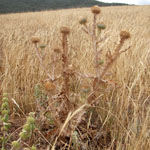Scotch thistle
Common name:
- Scotch thistle
Scientific name:
- Onopordum acanthium L.
Other common name:
- Heraldic thistle
Plant status
Catchment management authority boundaries
Regionally prohibited in the North Central, Port Phillip and Western Port catchments.
Regionally controlled in the Glenelg Hopkins, Corangamite, Goulburn Broken, North East, West Gippsland and East Gippsland catchments.
Restricted in the Mallee and Wimmera catchments.
Plant biology
Appearance
Herbaceous plant — Forb (flowering herbaceous plant — not a grass)
Description
Scotch thistle is an erect annual or biennial herb growing to 2m high and reproducing by seed and root pieces.
Stems
Scotch thistle generally has 1 main stem with numerous branches and broad spiny wings covered with dense woolly hairs, giving a whitish appearance.
Leaves
Leaf margins of scotch thistle are cut or toothed, spiny and undulating. Dense, white woolly hairs grow on the undersides of leaves and are sometimes sparser on upper sides.
Rosette leaves are stalked and grow up to 40cm long. Stem leaves are smaller and without stalks, extending into wings along the stems.
Flowers
Scotch thistle florets are purple or mauve in heads surrounded by numerous spiny bracts (modified leaves at the base of flower). Heads are 2 to 6cm in diameter, solitary or in groups towards the ends of the branches.
Bracts are woolly at the base and end in orange spines. Flowers are produced in late spring and summer.
Fruit
No fruit.
Seeds
Seeds of scotch thistle are 4 to 5mm long, grey with dark mottling and are attached to a pappus (parachute) of toothed hairs or bristles up to twice as long as the seed.
The pappus is often detached from the seed in the head.
Growth and lifecycle
Method of reproduction and dispersal
The major means of dispersal for the scotch thistle is by seed, but it can also be spread from severed root pieces.
Rate of growth and spread
Scotch thistle seeds can germinate at any time of the year, hence infestations consist of plants of various ages and sizes. There are 2 main periods of germination — late summer-autumn and late winter-spring.
Seedbank propagule persistence
Scotch thistle is a prolific seeder and a single plant can produce more than 20,000 seeds.
Preferred habitat
Scotch thistle prefers sub-humid temperate regions and grows well in soils of moderate to high fertility. The weed is competitive in annual rainfall areas of 500 to 850mm. It does not grow well on waterlogged soils.
Growth calendar
The icons on the following table represent the times of year for flowering, seeding, germination, the dormancy period of scotch thistle grass and also the optimum time for treatment.
| Jan | Feb | Mar | Apr | May | Jun | Jul | Aug | Sep | Oct | Nov | Dec | |
|---|---|---|---|---|---|---|---|---|---|---|---|---|
| Flowering | ||||||||||||
| Seeding | ||||||||||||
| Germination | ||||||||||||
| Dormancy | ||||||||||||
| Treatment |
Impact
Agricultural and economic impacts
Scotch thistle competes well with pasture resulting in them being overrun by this weed. It is not grazed by stock due to its dense spines. Animals rarely eat the plant.
Management
Prescribed measures for the control of noxious weeds:
- application of a registered herbicide
- physical removal.
Read about prescribed measures for the control of noxious weeds.
Other management techniques
Changes in land use practices and spread prevention may also support Scotch thistle management after implementing the prescribed measures.